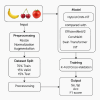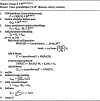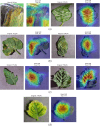Robust multiclass classification of crop leaf diseases using hybrid deep learning and Grad-CAM interpretability
- PMID: 40817123
- PMCID: PMC12356958
- DOI: 10.1038/s41598-025-14847-7
Robust multiclass classification of crop leaf diseases using hybrid deep learning and Grad-CAM interpretability
Abstract
The key objective of this study is to propose an effective and accurate deep learning (DL) framework to detect and classify diseases in banana, cherry, and tomato leaves. The performance of multiple pre-trained models is compared against a newly presented model.The experiments used a publicly released dataset of healthy and unhealthy leaves from banana, cherry, and tomato plants. This dataset was uniformly split into training, validation, and test sets to obtain consistent and unbiased model evaluations. The data pre-processing also involved pre-processing steps suitable for DL architectures to keep the input the same among all the models.We use several state-of-the-art pre-trained ConvNets models for the baselines, such as EfficientNetV2, ConvNeXt, Swin Transformer, and Vi-Transformer (ViT), to have an outlook on the performance. A new ConvNet-ViT hybrid model combines the ConvNet and ViT layers for local feature extraction and maintaining the global context. The classifier's performance was reinforced by a 5-fold cross-validation mechanism to avoid overfitting.The proposed Hybrid ConvNet-ViT model outperformed all the compared models evaluated, achieving a testing classification accuracy of 99.29%, which outperforms all the pre-trained models. This finding shows that combining ConvNets' local feature learning with the capability of global representation of the ViT is effective.The result shows that the Hybrid ConvNet-ViT model is an effective and accurate solution in detecting and classifying plant leaf diseases. Its outstanding performance of the state-of-the-art pre-trained top models positions itself as a solid model for practical agricultural use. Fusing the ConvNet and transformer frameworks jointly is beneficial for improving classification performance in image-based disease detection work.
Keywords: Classification; ConvNet; Deep learning; Hybrid ConvNet-ViT; Plant leaf disease; Vision transformer.
© 2025. The Author(s).
Conflict of interest statement
Declarations. Competing interests: The authors declare no competing interests.
Figures













References
-
- Benavides, M., Cantón-Garbín, M., Sánchez-Molina, J. A. & Rodríguez, F. Automatic tomato and peduncle location system based on computer vision for use in robotized harvesting. Appl. Sci.10 (17), 5887 (2020).
-
- Bai, Y., Mao, S., Zhou, J. & Zhang, B. Clustered tomato detection and picking point location using machine learning-aided image analysis for automatic robotic harvesting. Precision Agric.24 (2), 727–743 (2023).
-
- Gulzar, Y. Fruit image classification model based on mobilenetv2 with deep transfer learning technique. Sustainability15 (3), 1906 (2023).
-
- Moreira, G., Magalhães, S. A., Pinho, T., dos Santos, F. N. & Cunha, M. Benchmark of deep learning and a proposed Hsv colour space models for the detection and classification of greenhouse tomato. Agronomy12 (2), 356 (2022).
MeSH terms
LinkOut - more resources
Full Text Sources

